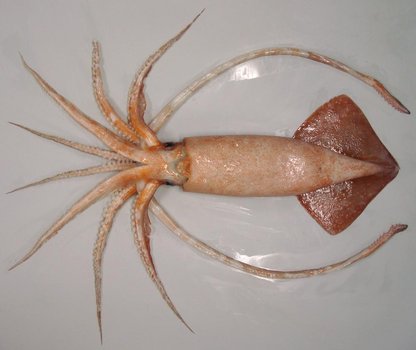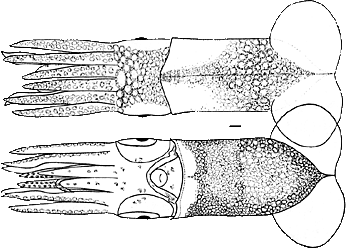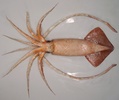Onykia (Moroteuthopsis) ingens
Michael Vecchione, Richard E. Young, and Kotaro TsuchiyaIntroduction
O. ingens reaches a length of at least 500 mm ML (Kubodera, et al., 1998) and is found in circumpolar but mostly sub-Antarctic waters.
Brief diagnosis:
An Onykia ...
- with rhomboidal fins (ie fins not drawn-out posteriorly).
- with warts on the skin.
- with rostrum of gladius having a triangular cross-section.
Characteristics
- Tentacles
- Club with usually 14 pairs of hooks (range - 13-16 hooks, dorsal series, 13-15, ventral series).
- Head
- Beaks: Descriptions can be found here: Lower beak; upper beak.
- Beaks: Descriptions can be found here: Lower beak; upper beak.
- Mantle
- Ventral mantle with soft, irregular warts.
- Fins
- Rhomboidal shape, not drawn out into a tail.
- Length 50-60% of ML.
- Width 60-70% of ML.
- Gladius
- Maximum width of vanes ca. 11% of gladius length (to tip of conus).
- Rostrum 11-12% of the ML, triangular in cross-section.
comments
This description is taken from Pfeffer (1912).Life History
The tentacular club of a young O. ingens, 77mm ML has a few marginal suckers still remaining on the proximal dorsal margin and on the distal ventral margin.


Figure. Oral view of tentacular club of O. ingens, 77 mm ML. Drawing from Tsuchiya and Okutani, 1981, p. 145, Fig. 35.
Dubinina (1980) described a juvenile squid from the Southwest Atlantic as Onykia robsoni (drawing to the right) but according to C. Nigmatullin (personal communication) it probably is a young O. ingens. The scale bar is 1 mm.
Distribution
This species is circumpolar in sub-Antarctic waters. A map of its distribution is found here.References
Clarke, M. R. 1980. Cephalopoda in the diet of sperm whales of the Southern Hemisphere and their bearing on sperm whale biology. Discovery Reports, 37: 1-324.
Dubinina, T. S. 1980. On a finding of a larvae Moroteuthis robsoni (Oegopsida, Onychoteuthidae) in South-west Atlantic.
T. Kubodera, U. Piatkowski, T. Okutani and M.R. Clarke. 1998. Taxonomy and Zoogeography of the Family Onychoteuthidae (Cephalopoda: Oegopsida). Smithsonian Contributions to Zoology, No. 586: 277-291.
Tsuchiya, K., and T. Okutani. 1991. Growth Stages of Moroteuthis robusta (Verrill, 1881) with the Re-evaluation of the Genus. Bulletin of Marine Science, 49(1/2):137-147.
Title Illustrations

| Scientific Name | Onykia (Moroteuthopsis) ingens |
|---|---|
| Location | SW Chatham Rise (near New Zealand) at 44░21'S, 175░32'E |
| Comments | Bottom trawl at at about 690 m depth |
| Acknowledgements | National Institute of Water & Atmospheric Research (NIWA) |
| Identified By | Darren Stevens |
| Sex | Female |
| Life Cycle Stage | Mature |
| View | Ventral |
| Size | 384 mm ML, 1875 g weight |
| Collection | NIWA |
| Image Use |
 This media file is licensed under the Creative Commons Attribution License - Version 3.0. This media file is licensed under the Creative Commons Attribution License - Version 3.0.
|
| Copyright | © |
| Scientific Name | Onykia ingens |
|---|---|
| Reference | Pfeffer, G. 1912. Die Cephalopoden der Plankton-Expedition. Zugleich eine Monographische ▄bersicht der Oegopsiden Cephalopoden. Ergebniss der Plankton- Expedition der Humboldt-Stiftung, 2:1-815. |
| Specimen Condition | Dead Specimen |
| View | Ventral, dorsal |
| Size | ca. 400 mm ML |
About This Page

National Museum of Natural History, Washington, D. C. , USA

University of Hawaii, Honolulu, HI, USA

Tokyo University of Fisheries, Tokyo, Japan
Page copyright © 2003 , , and
 Page: Tree of Life
Onykia (Moroteuthopsis) ingens .
Authored by
Michael Vecchione, Richard E. Young, and Kotaro Tsuchiya.
The TEXT of this page is licensed under the
Creative Commons Attribution-NonCommercial License - Version 3.0. Note that images and other media
featured on this page are each governed by their own license, and they may or may not be available
for reuse. Click on an image or a media link to access the media data window, which provides the
relevant licensing information. For the general terms and conditions of ToL material reuse and
redistribution, please see the Tree of Life Copyright
Policies.
Page: Tree of Life
Onykia (Moroteuthopsis) ingens .
Authored by
Michael Vecchione, Richard E. Young, and Kotaro Tsuchiya.
The TEXT of this page is licensed under the
Creative Commons Attribution-NonCommercial License - Version 3.0. Note that images and other media
featured on this page are each governed by their own license, and they may or may not be available
for reuse. Click on an image or a media link to access the media data window, which provides the
relevant licensing information. For the general terms and conditions of ToL material reuse and
redistribution, please see the Tree of Life Copyright
Policies.
- First online 23 June 2003
Citing this page:
Vecchione, Michael, Richard E. Young, and Kotaro Tsuchiya. 2003. Onykia (Moroteuthopsis) ingens . Version 23 June 2003 (under construction). http://tolweb.org/Onykia_%28Moroteuthopsis%29_ingens/19972/2003.06.23 in The Tree of Life Web Project, http://tolweb.org/














 Go to quick links
Go to quick search
Go to navigation for this section of the ToL site
Go to detailed links for the ToL site
Go to quick links
Go to quick search
Go to navigation for this section of the ToL site
Go to detailed links for the ToL site